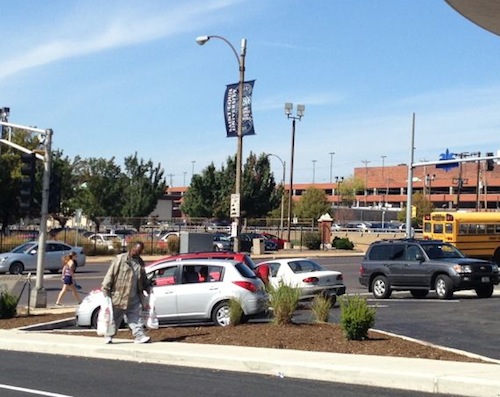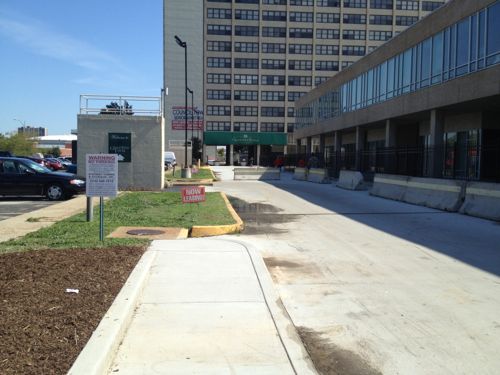Pedestrian Access To Council Plaza Residential Towers Marginally Improved
Last year I wrote about pedestrian access to the two high rise towers at the Council Plaza complex on Grand (see: Pros & Cons of Saving the 1960s Flying Saucer at Grand & Forest Park). With the renovation of the saucer the pedestrian access for residents of the two towers has improved…somewhat.

The problem noted last year was the developer fenced off an area around the lower building between the first tower and Grand. This forced residents, many seniors and disabled, to use the long auto driveway. This change reduced access — a clear violation of the ADA.


Hopefully the developer plans to continue this sidewalk as part of a future project. Unfortunately it is not as wide as the sidewalk that got fenced off — two wheelchair users going in the opposite direction couldn’t pass each other. At this site, that might happen several times a day.

Access was fine until the fence was installed a year or two ago, and now a narrow sidewalk that doesn’t go far enough is s marginal attempt to fix the problem they created. We need local regulation so seniors and disabled do not have to walk in auto driveways to get home.
— Steve Patterson
Your first picture illustrates a point I was making previously – design professionals can (try to) do all the right things, yet once a facility is completed and occupied, owners do many things, in the name “security” or just because they can, that screw up the original design. This is a case where the city may or may not have jurisdiction (is a permit required for a fence of this height? from whom? Zoning? Building? Fire?) and they may or may not have exercised their jurisdiction properly (blocking an existing sidewalk? impeding emergency egress?). Part of it is what work requires permits, and what does not, and part of it is that many things can, and are, done without permits or city review.
The fundamental issue is one of context. The third photo shows the new sidewalk stopping where the flying saucer “project” ends and where the existing parking lot remains unchanged. In a perfect, ideal world, yes, the developer “should” have connected both towers, as well as redoing all the public curb ramps for several blocks around, but that ain’t reality. There are limited funds and the new sidewalk is just that, new, there was no sidewalk there before this renovation. It’s an improvement, but it’s not perfect. A better “solution” may actually be counter intuitive – instead of ending with a vertical curb at the sewer inlet, end with a curb ramp, provide a painted crosswalk at 90 degrees, then continue the pedestrian path behind the existing concrete jersey barriers. No, that’s not “perfect” either, but it would at least provide a safer, continuous path of travel at little or no additional cost.
This fence was part of a very expensive renovation project designed by licensed architects!!
You seem to be working under the assumption that every time an architect (or an engineer) says “Jump!”, the client says “How high?” In the real world, unless it’s a true life-safety issue, it’s usually the other way around. In this case, have you seen the plans that show(ed) this fence? Or, are you just assuming that just because it’s a part of the project, the architect is the one that first (and finally) said “Put it here”?
I’m just know better than to believe these things happen after the professionals have finished their work — they were involved.
In the old days, before everything was corporate-profit orientated, architectural firms and designers did actually bring both problems and potentials to the attention of the developer.
These days it is more of a situation of full steam ahead and stick as much money in your pocket as possible and forget about ethical and design issues. Not all architects operate this way, there are still a few more concerned about art and well done solutions, but usually corporate architects are hired for these larger projects.
Thus you end up with the situation of almost completely ignoring the needs of pedestrians, both here and at Starbucks.
Architects have become part of the problem, and when greed rules, it is why you need regulations.
There is no such thing as a professional architect any more. That implies there are values involved.
Steve. You actually don’t know better. Let me offer an owner perspective (b/c I deal with it daily). Owner says why do I need item “X”, Architect tells owner it’s for safety and code, owner agrees. Job gets the blessing from the code authorities and guess what happens to item “X”? It goes in the trash can or gets removed. It happens all the time.
That doesn’t excuse it, but the architect is absolutely not told about every last minute change once the building is approved.